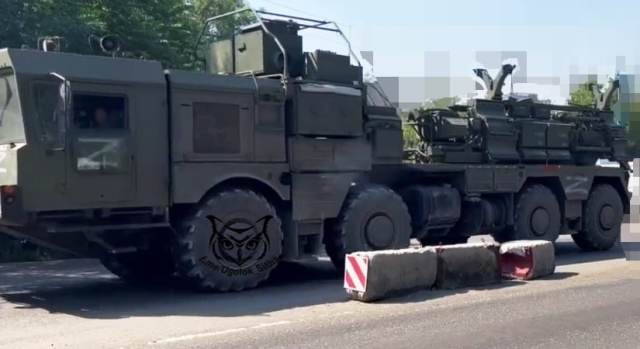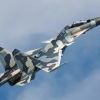The events of the Russian special military operation in Ukraine were actually the first large-scale combat test in real combat conditions of most modern weapons of both Soviet and Russian and Western production. The conflict has become for the domestic defense industry a brutal test of its products by fighting with a relatively technically and organizationally equivalent opponent, and enjoying large-scale advanced technical support from the West. This fully applies to the Russian air defense systems, the generation of which, created since the eighties, until recently either had no significant combat use at all, or was used in combat sporadically, and in a fairly simple situation, rather close to the landfill.

Self-propelled launcher 51P6A on the chassis of MZKT-7930 with the possibility of using anti-aircraft guided missiles of the 48N6 and 9M96 series, which is part of the S-400 "Triumph" anti-aircraft missile system of the Russian Armed Forces, filmed in Donbass, July 2022 (c) Telegram channel "Sith Corner"
Now, in Ukraine, we can see the unprecedented use of the entire range of domestic modern anti-aircraft missile systems in all the variety of combat situations and in confrontation with the most diverse means of air attack. Soviet and Russian Air defense Forces, and primarily anti-aircraft missile forces, have not received such combat experience since their inception in history.
The main characteristic feature of the use of Russian anti-aircraft missile systems in their own is that they have to deal not so much with enemy aircraft - since the small Air Forces of Ukraine operate mainly in "guerrilla" ways and are successfully knocked out in the air by Russian fighter aircraft - but with a variety of enemy surface-to-ground missile systems, and also with unmanned vehicles. Moreover, the old Soviet multiple launch rocket systems "Grad", "Hurricane" and "Smerch", which were previously massively used by the Ukrainian side, and the operational-tactical missile complexes "Tochka-U" are increasingly being replaced by HIMARS and MLRS missile systems supplied by Western partners. The peculiarity of these American complexes is equipping them with high-precision GMLRS missiles with a firing range of up to 80-90 km, and not far off, apparently, and Ukraine receiving to these complexes and longer-range GMLRS ER missiles with a range of up to 150-180 km, and then operational-tactical ATACMS missiles with a range of at least 300 km.
Thus, Russian anti-aircraft missile systems in Ukraine face the tasks primarily of anti-missile warfare. Moreover, anti-missile warfare is not with single launches of ballistic missiles - which the American Patriot complexes have tried to cope with with varying success from the 1991 Gulf War to the current fight against the missiles of the Yemeni Houthis in Saudi Arabia - but with the massive volley use (often dozens) of guided and unguided missiles of multiple launch rocket systems. Often, moreover, these missiles are launched in various combinations to saturate and break through air defense systems. Needless to say, medium- and long-range anti-aircraft missile systems of both military air defense, and even more so of the country's air defense forces, were not created for the tasks of combating such missiles and in such conditions, and the fight against such targets, if worked out by calculations during combat training, then very infrequently and rather in a simplified manner.
Nevertheless, we can see an unusually high effectiveness of the combat use of modern Russian anti-aircraft missile systems in the area of its missile defense tasks - of course, when the systems are correctly placed, provide sufficient cover density, are competently used and have established interaction with detection forces, combat control and other air defense means. While, of course, it is not the time to give specific figures and indicators of combat performance, but the available information indicates a large number of effective interceptions of the most difficult targets by Russian anti-aircraft weapons. First of all, this applies to the most advanced S-400 anti-aircraft missile systems, using the entire range of anti-aircraft guided missiles available to them. In fact, in the area of operation of the S-400 divisions, most of the Ukrainian missiles fired at the objects they cover are steadily intercepted. The anti-aircraft missile systems of the S-300V, S-300P and Buk series are also very effective. At the same time, one should not forget that the most effective interception of enemy missiles flying along ballistic trajectories is possible only at the final section of their trajectory, which significantly limits the actual interception range and the radius of cover.
Nevertheless, it is obvious that a front with a length of almost 2500 km and requiring a cover depth of 300 km deep into its territory cannot be covered with a solid S-400 stockade with the desired density, especially since the systems themselves cannot be placed too close to the line of contact. Priority is clearly given to the protection of large cities and settlements, communication hubs, supply centers (logistics hubs), higher headquarters and management bodies, combat aviation airfields, and first of all on the Russian territory itself. During the five months of its existence, there were no known facts of massive destruction of the above-mentioned objects by missile strikes - only individual missiles broke through to the targets.
Of course, the appearance of high-precision long-range weapons of destruction in the form of HIMARS and MLRS complexes and GMLRS missiles strengthens the existing challenges for the organization of missile defense, but from a technical point of view does not fundamentally change anything for anti-aircraft missile weapons. Technically, the salvo of the old Soviet "Hurricane" as a target for air defense is more difficult than the salvo of the HIMARS installation. Nevertheless, the "Hurricanes" missiles have been intercepted many times and are being intercepted in combat conditions. Therefore, the arguments that "S-400 cannot counteract HIMARS", especially those launched in the Western media, are absurd and illiterate. The S-400 can counteract and successfully counteracts HIMARS missiles, demonstrating the highest level of design solutions embedded in our flagship air defense system.
At the same time, it should be noted that the very confrontation of modern Russian anti-aircraft missile systems with modern Western strike missile systems itself occurred in Ukraine for the first time. The characteristics of the same GMLRS missiles are now being carefully studied by Russian specialists in order to optimize the means and methods of countering them and increase the effectiveness of our air defense systems.
Domestic anti-aircraft missile systems with real combat use in their own significantly exceeded the level of efficiency set during their creation, especially for ballistic targets. Air and missile defense is precisely the sphere of military equipment where Russia was able to give a modern military-technical response to advanced Western strike complexes.





